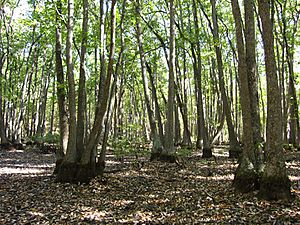Nyssa biflora facts for kids
Quick facts for kids Nyssa biflora |
|
|---|---|
 |
|
| Conservation status | |
| Scientific classification | |
| Genus: |
Nyssa
|
| Species: |
biflora
|
Nyssa biflora, often called the swamp tupelo or swamp black-gum, is a special kind of tupelo tree. It loves to live in wetland areas, like swamps and marshes. You can find swamp tupelo trees mainly along the coastal plains of the United States. They grow from Delaware all the way down to southern Florida, and west to eastern Texas. They also spread north up the Mississippi Valley into parts of Arkansas and Tennessee.
Contents
Where Swamp Tupelo Trees Grow
Swamp tupelo trees grow best in warm, humid places. They don't just put up with floods; they actually do really well when their roots are underwater! You'll rarely find these trees in spots that aren't flooded for much of the year.
Favorite Wet Places
These trees like to live in many wet environments. This includes the upper parts of swamps, special long, narrow swamps called strands, ponds, and river bottoms. They also grow in bays, estuaries (where rivers meet the sea), and low, sheltered areas. However, you usually won't find them in the very deepest parts of swamps or in river areas that flood too much.
Water and Soil Needs
For swamp tupelo, the way water moves is more important than the type of soil. They grow best where the soil is always wet with shallow, moving water. If the water is still, like in a pond, their growth can slow down by half. Growing can also be harder if the water floods and dries out often. Even deep, moving water can slow their growth.
Plant Neighbors
Many other trees and shrubs often grow near swamp tupelo. Some common plant neighbors include red maple (Acer rubrum), buttonbush (Cephalanthus occidentalis), and swamp cyrilla (Cyrilla racemiflora). Other plants like Carolina ash (Fraxinus caroliniana), loblolly-bay (Gordonia lasianthus), and different kinds of holly (like dahoon, inkberry, and yaupon) are also often found nearby.
Swamp Tupelo Life Cycle
The swamp tupelo has tiny greenish-white flowers. These flowers appear in the spring, usually in late April, at the same time as the leaves.
How They Reproduce
Insects, especially bees, help spread the pollen from flower to flower. The wind also helps carry some pollen. The fruit of the swamp tupelo is a type of berry called a drupe. It starts green and turns a dark blue when it's ripe, usually around early November.
Seed Germination
The seeds usually stay dormant over the winter. They then start to grow the following spring. Seeds won't sprout if they are underwater. But once the water goes down below the soil, they will begin to grow. Seeds grow quickly in moist, drained soil when the temperature is around 21°C (70°F) or warmer.
After a seed sprouts, the young plant must grow fast. It needs to keep its top part and leaves above the water. If a young seedling stays underwater for too long while it's actively growing, it can die. However, if it's underwater when it's not actively growing (during its dormant season), it won't be harmed.
Special Roots for Flooding
Swamp tupelo trees usually grow a strong main root called a taproot. The base of the tree also swells up to the average water level during the growing season. These trees also grow special "water roots" when they are flooded. These roots help the tree stay stable and take in nutrients.
These special roots can handle high amounts of carbon dioxide in the water. They also help clean the soil around them and can even breathe without much oxygen. This is why swamp tupelo trees are so good at living and growing in flooded conditions!


